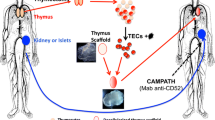Summary
Cultured thymic fragments correspond to the thymic microenvironment depleted of lymphocytes and dendritic cells. When these fragments are implanted under the kidney capsule of congenitally athymic rats, lymphocytes and dendritic cells of host origin enter the graft and induce thymus-dependent immunity in the recipient. This paper describes the ultrastructure of the fragments and the changes that occur during the restoration of normal thymic architecture. At the end of the culture period of 6–9 days and in the early stages after implantation, the grafts consist of keratin-containing epithelial cells of unusual morphology that can be labelled with antibodies raised against the epithelium of the mid/deep cortex and the subcapsule/medulla. Normal thymic architecture develops, including nerves and blood vessels, as lymphocytes populate the environment, and by 4–6 weeks the epithelial cells are the same phenotypically and ultrastructurally as those found in normal rat thymus. However, some areas without lymphocytes still contain the atypical epithelial cells seen before implantation. Large multinucleated giant cells are also present with a few associated epithelial cells of subcapsular/medullary phenotype. In conclusion, the cultured thymic fragments contain a hitherto unknown precursor epithelial cell with an atypical ultrastructure and phenotype that is not seen in normal development.
Similar content being viewed by others
References
Blau JN (1967) The dynamic behaviour of Hassall's corpuscles and the transport of particulate matter in the thymus of the guinea-pig. Immunology 13:281–292
Danner SA, Schuurman H-J, Lange JMA, Gmelig Meyling FHJ, Schellekens PThA, Huber J, Kater L (1986) Implantation of cultured thymic fragments in patients with acquired immunodeficiency syndrome. Arch Int Med 146:1133–1136
Douarin NM le, Jotereau FV (1981) The ontogeny of the thymus. In: Kendall MD (ed) The thymus gland. Academic Press, London, pp 37–62
Duijvestijn AM, Hoefsmit EC (1981) Ultrastructure of the rat thymus: the micro-environment of T-lymphocyte maturation. Cell Tissue Res 218:279–292
Duijvestijn AM, Sminia T, Köhler YG, Janse EM, Hoefsmit EC (1984) Ontogeny of the rat thymus micro-environment: development of the interdigitating cell and macrophage populations. Dev Comp Immunol 8:947–956
Felten DL, Felten SY, Carlson SL, Olschowka JA, Livnat S (1985) Noradrenergic and peptidergic innervation of lymphoid tissue. J Immunol 135:7558–7658
Gaudecker B von (1986) The development of the human thymus microenvironment. Curr Top Pathol 75:1–41
Hong R, Schulte-Wissermann H, Jarrett-Toth E, Horowitz SD, Manning DD (1979) Transplantation of cultured thymic fragments. II. Results in nude mice. J Exp Med 149:398–415
Jordan RK, Bentley AL, Perry GA, Crouse DA (1985) Thymic epithelium. I. Lymphoid-free organ cultures grafted in syngeneic intact mice. J Immunol 134:2155–2160
Kampinga J, Kroese FGM, Duijvestijn AM, Murawska MB, Pol GH, Nieuwenhuis P (1987) The rat thymus microenvironment: subsets of thymic epithelial cells defined by monoclonal antibodies. Transplant Proc 19:3171–3174
Kendall MD, Blackett NM (1983) Ultrastructural studies on the thymus gland after the administration of phenylhydrazine to bank voles (Clethrionomys glareolus). Cell Tissue Res 232:201–219
Kendall MD, Yaffe P, Yoffey JM (1985) The mouse thymus in hypoxia and rebound: a histologic study. J Anat 142:85–102
Kendall MD, Al-Shawaf A, Zaidi SAA (in press) The cholinergic and adrenergic innervation of the rat thymus. Adv Exp Med Biol
Lobach DF, Haynes BF (1987) Ontogeny of the human thymus during fetal development. J Clin Immunol 7:81–97
Nabarra B, Andrianarison I (1987) Ultrastructural studies of thymic reticulum: I. Epithelial component. Thymus 9:95–121
Norris EH (1938) The morphogenesis and histiogenesis of the thymus gland in man: in which the origin of the Hassall's corpuscles of the human thymus is discovered. Contr Embryol 166:193–207
Schulte-Wissermann H, Manning D, Hong R (1978) Transplantation of cultured thymic fragments. I. Morphologic and technical considerations. Scand J Immunol 8:387–396
Schuurman H-J (1988) Biological functions of the thymic microenvironment. Thymus Update 1 (in press)
Schuurman HJ, Vos JG, Van de Brink E, Kater L (1982) Culture of thymic epithelium for transplantation purposes: morphological characterization and in vivo biological effect on thymus-dependent immunity in athymic (nude) rats. Clin Immunol Immunopathol 24:418–431
Schuurman HJ, Vos JG, Broekhuizen R, Brandt CJWM, Kater L (1985a) In vivo biological effect of allogeneic cultured thymic epithelium on thymus-dependent immunity in athymic nude rats. Scand J Immunol 21:21–30
Schuurman H-J, Van de Wijngaert FP, Huber J, Schuurman RKB, Zegers BJM, Roord JJ, Kater L (1985b) The thymus in “bare lymphocyte” syndrome: significance of expression of major histocompatibility complex antigens on thymic epithelial cells in intrathymic T-cell maturation. Human Immunol 13:69–82
Schuurman H-J, Vaessens LMB, Vos JG, Hertogh A, Geertzema JGN, Brandt CJWM, Rozing J (1986) Implantation of cultured thymic fragments in congenitally athymic nude rats: ignorance of thymic epithelial haplotype in generation of alloreactivity. J Immunol 137:2440–2447
Schuurman H-J, Vaessen LMB, Broekhuizen R, Brandt CJWM, Holewijn MC, Vos JG, Rozing J (1987) Implantation of cultured thymic fragments in congenitally athymic (nude) rats. Influx of lymphocytes and dendritic cells. Scand J Immunol 26:129–139
Singh J (1981) The ultrastructure of epithelial reticular cells. In: Kendall MD (ed) The thymus gland. Academic Press, London, pp 133–150
Wijngaert FP van de, Kendall MD, Schuurman H-J, Rademakers LHPM, Kater L (1984) Heterogeneity of epithelial cells in the human thymus. An ultrastructural study. Cell Tissue Res 237:227–237
Willcox N, Schluep M, Ritter MA, Schuurman HJ, Newsom-Davis J, Christensson B (1987) Myasthenic and nonmyasthenic thymoma. An expansion of a minor cortical epithelial cell subset? Am J Pathol 127:447–460
Author information
Authors and Affiliations
Rights and permissions
About this article
Cite this article
Kendall, M.D., Schuurman, HJ., Fenton, J. et al. Implantation of cultured thymic fragments in congenitally athymic (nude) rats. Cell Tissue Res. 254, 283–294 (1988). https://doi.org/10.1007/BF00225801
Accepted:
Issue Date:
DOI: https://doi.org/10.1007/BF00225801




